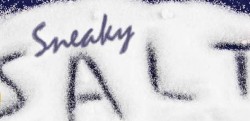Here’s how to keep your sodium intake in check. “Reduced sodium.” “Lower sodium.” “Contains less salt!” These phrases are often proudly emblazoned on our favorite foods — from predictably salty snacks, like peanuts and pretzels, to more surprising sodium vehicles, like bread, cereal and even chicken.
“Reduced sodium.” “Lower sodium.” “Contains less salt!” These phrases are often proudly emblazoned on our favorite foods — from predictably salty snacks, like peanuts and pretzels, to more surprising sodium vehicles, like bread, cereal and even chicken.
Sodium is a naturally occurring mineral. Because it is highly reactive in its pure form, it is always found in compounds with other minerals: For example, sodium combines with chloride to form sodium chloride, also known as table salt. Consumed in appropriate amounts, sodium helps the body maintain a balance between water and minerals, and it regulates blood volume. Most adults need about 1,500 milligrams — but no more than 2,300 milligrams (about one teaspoon) — of sodium per day.
However, most of us get much more than a teaspoon of salt per day. And high levels of sodium can have serious side effects on health. Most notably, excess sodium can contribute to high blood pressure, which has serious complications of its own, including raising the risk of heart disease and stroke.
To lower your risk of high blood pressure and related complications, start cutting back on your sodium intake. As you decrease the amount of salt in your diet, your taste buds will readjust — and you just might find yourself more sensitive to salt.
Slash the Salt and Savor the Flavor
Add zest with herbs and spices first. Make basil, oregano, thyme and black or cayenne pepper your go-to seasonings while cooking. Taste often, and, when a recipe calls for salt, try adding half of the recommended amount first.
Read the label! We’ve said it before, and we’ll say it again: There’s no better way to know what you’re putting in your body than by reading a food’s ingredient label. When you’re going through a ranked list of ingredients, watch where salt comes in. If salt or sodium ranks high on the list of ingredients, limit your intake of that food or find an alternative with lower sodium.
Buy fresh or fresh-frozen. Canned vegetables, and even fruits, contain a much higher percentage of salt than their fresh or fresh-frozen counterparts. If the veggie you want is out of season and you have to buy it canned, empty the can’s contents into a strainer and rinse to remove excess salt before eating.
Be conscious of diet food. Though we often think that reaching for a low-calorie or low-fat food will make us healthier, these alternatives usually contain extra salt to make up for their lack of fat or other high-calorie ingredients. If you’re watching your waistline, try sticking to stricter portion control and healthy snacks — rather than loading up on salty diet food.
